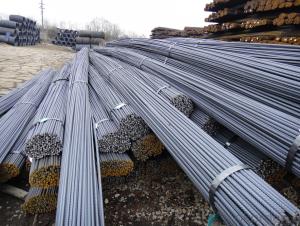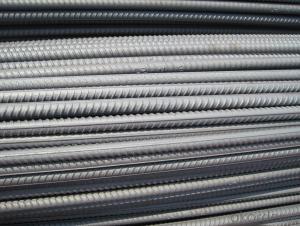Steel Ribbed Bar For Construction Hot Rolled
- Loading Port:
- China main port
- Payment Terms:
- TT OR LC
- Min Order Qty:
- 25 m.t.
- Supply Capability:
- 10000 m.t./month
OKorder Service Pledge
OKorder Financial Service
You Might Also Like
Specifications
Standard | GB | HRB400 | |
Diameter | 6mm,8mm,10mm,12mm,14mm,16mm,18mm,20mm, 22mm,25mm,28mm,32mm,36mm,40mm,50mm | ||
Length | 6M, 9M,12M or as required | ||
Place of origin | Hebei, China mainland | ||
Advantages | exact size, regular package, chemical and mechanical properties are stable. | ||
Type | Hot rolled deformed steel bar | ||
Chemical Composition: (Please kindly find our chemistry of our material based on HRB500 as below for your information)
Grade | Technical data of the original chemical composition (%) | ||||||
C | Mn | Si | S | P | V | ||
HRB400 | ≤0.25 | ≤1.60 | ≤0.80 | ≤0.045 | ≤0.045 | 0.04-0.12 | |
Physical capability | |||||||
Yield Strength (N/cm²) | Tensile Strength (N/cm²) | Elongation (%) | |||||
≥400 | ≥570 | ≥14 | |||||
Usage and Applications
Deformed bar is widely used in buildings, bridges, roads and other engineering construction. Big to highways, railways, bridges, culverts, tunnels, public facilities such as flood control, dam, small to housing construction, beam, column, wall and the foundation of the plate, deformed bar is an integral structure material. With the development of world economy and the vigorous development of infrastructure construction, real estate, the demand for deformed bar will be larger and larger..
Packaging & Delivery
Packaging Detail: products are packed in bundle and then shipped by container or bulk vessel, deformed bar is usually naked strapping delivery, when storing, please pay attention to moisture proof. The performance of rust will produce adverse effect.
Each bundle weight: 2-3MT, or as required
Payment term: TT or L/C
Delivery Detail: within 45 days after received advanced payment or LC.
Label: to be specified by customer, generally, each bundle has 1-2 labels
Trade terms: FOB, CFR, CIF
Note
1. Our products are produced according to national standard (GB), if not, supply according to national standards (GB) or agreement as customer required.
2. Other Grade and Standard Deformed Steel Bar we can supply:
Grade: GR40/GR60, G460B/B500A/B500B/B500C,BST500S
Standard: ASTM, BS, DIN
The Minimum Order Quantity of these products is high, and need to be confirmed.
3. We can not only supply Deformed Steel Bar; if you need anything about building materials, please contact us for further information.
4. Please send us your detail specifications when inquire. We will reply to you as soon as possible. We sincerely hope we can establish a long stable business relationship.
- Q:Can steel rebars be used in the construction of shopping malls and commercial buildings?
- Yes, steel rebars can be used in the construction of shopping malls and commercial buildings. Steel rebars provide strength, durability, and reinforcement to the concrete structures, ensuring the safety and stability of the buildings. They are commonly used in the construction industry for their ability to withstand heavy loads and resist bending or breaking. Additionally, steel rebars are versatile and can be easily molded into different shapes, making them suitable for various structural designs in shopping malls and commercial buildings.
- Q:What are the different types of steel rebars used in earthquake-prone regions?
- In earthquake-prone regions, several types of steel rebars are commonly used, including carbon steel rebars, stainless steel rebars, and epoxy-coated rebars. Carbon steel rebars are the most widely used due to their high strength and cost-effectiveness. Stainless steel rebars provide excellent corrosion resistance and durability, making them suitable for aggressive environments. Epoxy-coated rebars offer protection against corrosion and are often used in locations with high moisture content. The choice of rebar type depends on the specific requirements and conditions of the earthquake-prone region.
- Q:Can steel rebars be used in tunnel boring machine (TBM) construction?
- Yes, steel rebars can be used in tunnel boring machine (TBM) construction. Rebars are commonly used in the construction industry to reinforce concrete structures, including tunnels constructed using TBMs. The purpose of using rebars is to provide additional strength and durability to the concrete lining of the tunnel. These rebars are typically placed within the concrete lining during the construction process to enhance its structural integrity and ability to withstand external forces. In TBM construction, the rebars are carefully positioned and secured to ensure proper reinforcement throughout the tunnel. Therefore, steel rebars play a crucial role in the construction of tunnels using TBMs.
- Q:What are the different types of surface finishes available for steel rebars?
- Steel rebars come in a variety of surface finishes, each with its own unique characteristics and advantages. Let's take a look at some of the most common types: 1. Black/Uncoated Finish: The simplest surface finish for steel rebars is leaving them in their natural state without any additional coating or treatment. While this finish doesn't provide corrosion protection, it is often used when the rebars will be encased in concrete. 2. Epoxy-Coated Finish: This finish involves applying a layer of epoxy coating to the surface of the rebar. The coating offers excellent corrosion resistance and increases the lifespan of the rebar. Epoxy-coated rebars are commonly used in marine environments or structures exposed to harsh weather. 3. Galvanized Finish: Galvanizing is the process of adding a layer of zinc coating to the rebar's surface. This coating acts as a barrier against corrosion and provides long-lasting protection. Galvanized rebars are frequently used in areas with high moisture content or structures exposed to corrosive chemicals. 4. Stainless Steel Finish: Stainless steel rebars are made from a corrosion-resistant alloy with a high chromium content. This finish is extremely resistant to corrosion, even in challenging environments. It is commonly used in structures that require long-term durability, such as bridges and parking garages. 5. Ribbed Finish: Ribbing refers to the pattern or texture added to the rebar's surface. This finish improves the bond strength between the rebar and the surrounding concrete, enhancing the structural integrity of the construction. Ribbed finishes are often used in reinforced concrete structures. When choosing a surface finish for steel rebars, it's crucial to consider the specific requirements of your project. Factors such as environmental conditions, moisture or chemical exposure, and the desired lifespan of the structure will all influence your choice. Seeking advice from a structural engineer or construction professional can help you determine the most suitable finish for your particular application.
- Q:What is the purpose of steel rebars in construction?
- The purpose of steel rebars in construction is to provide reinforcement and strength to concrete structures, preventing cracking and ensuring stability.
- Q:How do steel rebars affect the overall aesthetics of a building?
- Steel rebars can have a significant impact on the overall aesthetics of a building. While they are primarily used for structural purposes, their visibility can affect the visual appeal of the structure. Exposed steel rebars can create an industrial or modern aesthetic, giving a building a contemporary and edgy look. However, if not properly integrated or concealed, the presence of steel rebars can also be perceived as unsightly or unfinished, detracting from the overall aesthetics of the building.
- Q:Can steel rebars be used in bridges?
- Yes, steel rebars can be used in bridges. Steel rebars are commonly used as reinforcement in concrete structures, including bridges. They provide added strength and stability to the concrete, making it able to withstand heavy loads and forces. The use of steel rebars in bridges helps to enhance their durability and structural integrity, ensuring the safety of the bridge and the people using it. Additionally, steel rebars have excellent tensile strength, which is necessary to counteract the tensile forces that bridges often experience. Overall, steel rebars are an essential component in the construction of bridges, contributing to their strength, longevity, and safety.
- Q:How long do steel rebars last?
- Steel rebars typically have a long lifespan and can last for several decades, with proper maintenance and protection against corrosion.
- Q:How do steel rebars impact the overall construction cost estimation process?
- The overall construction cost estimation process is significantly influenced by steel rebars. These reinforcing bars play a crucial role in reinforced concrete structures, providing strength and durability to the building. Consequently, including them in the cost estimation is essential for accurately assessing the total project cost. To begin with, the material cost of the construction project is impacted by steel rebars. Rebars are typically priced based on weight, so the quantity and size of rebars required directly affect the material cost estimation. Accurately identifying and quantifying rebars is necessary to ensure an appropriate budget allocation for the project. Furthermore, labor cost estimation is also influenced by steel rebars. Skilled labor is required to install rebars, and the time and effort involved in cutting, bending, and placing the rebars must be taken into account. The complexity of the reinforcement design, such as intricate shapes or complex detailing, can increase labor costs. Therefore, accurately estimating rebars allows for better planning of labor resources and cost allocation. In addition to material and labor costs, steel rebars impact other aspects of the construction cost estimation process. For example, the weight and placement of rebars affect the structural design, which can influence the cost estimation of the concrete mix design and formwork requirements. The size and spacing of rebars may also impact the excavation and foundation costs, as well as the overall project timeline. Moreover, steel rebars contribute to the long-term costs of the construction project. The quality and durability of rebars directly affect the lifespan and maintenance requirements of the structure. Investing in high-quality rebars can reduce future maintenance and repair costs, as well as enhance the overall life cycle cost analysis of the project. To conclude, the overall construction cost estimation process is significantly impacted by steel rebars. Accurately estimating rebars is essential for determining material and labor costs, as well as influencing other cost-related aspects of the project. It allows for precise budget allocation, resource planning, and consideration of long-term costs, ultimately resulting in a more reliable and comprehensive construction cost estimation.
- Q:What's the difference between primary and two grade steel and three grade steel?
- There are two levels of steel rebar, three steel, four steel grade difference, no grade steel, there are a lot of customers to wire (round) mistakenly called a steel. At present, China is gradually out of grade two steel, four steel grade two steel grade HRB335, three grade steel grade HRB400, four grade of steel wire is HRB500, (Pan Yuan) new material grades are HPB195, HPB235, HPB300, old wire material grades corresponding is Q195, Q235.
1. Manufacturer Overview |
|
|---|---|
| Location | |
| Year Established | |
| Annual Output Value | |
| Main Markets | |
| Company Certifications | |
2. Manufacturer Certificates |
|
|---|---|
| a) Certification Name | |
| Range | |
| Reference | |
| Validity Period | |
3. Manufacturer Capability |
|
|---|---|
| a)Trade Capacity | |
| Nearest Port | |
| Export Percentage | |
| No.of Employees in Trade Department | |
| Language Spoken: | |
| b)Factory Information | |
| Factory Size: | |
| No. of Production Lines | |
| Contract Manufacturing | |
| Product Price Range | |
Send your message to us
Steel Ribbed Bar For Construction Hot Rolled
- Loading Port:
- China main port
- Payment Terms:
- TT OR LC
- Min Order Qty:
- 25 m.t.
- Supply Capability:
- 10000 m.t./month
OKorder Service Pledge
OKorder Financial Service
Similar products
New products
Hot products
Related keywords




























